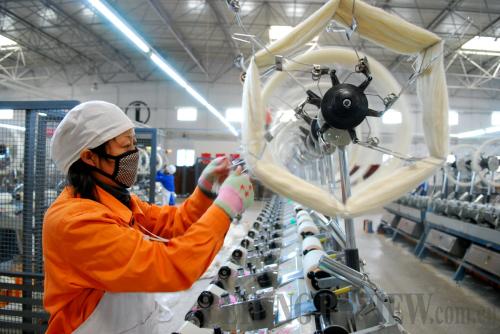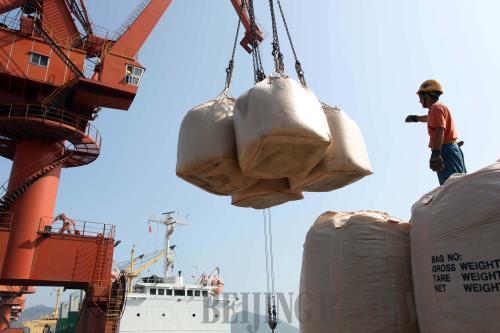|
 |
|
TEXTILE PROSPERITY: Employees weave wool in a workshop at the Qinghai Tibetan Sheep Carpets (Group) Ltd., a major exporter of wool products in northwest Qinghai Province (WU GUANGYU) |
Running in and out of his factory making adjustments and fixing odds and ends, Wang Kang, General Manager of Zhejiang Tianfang Co. Ltd., was finally busy again after nearly half a year of inactivity. The hectic day was a warm welcome—it was the first time the private textile manufacturer had restarted its idled assembly lines since May, when export demand all but dried up in the wake of the financial chaos.
Rows of machines buzzed, while a few newly hired workers in uniform tinkered with an assortment of textile equipment. Everything appeared to be back to normal.
A turning point occurred in October when the company received two large orders from American buyers.
"I didn't expect to recover from the downturn so soon given how bleak the market was," said Wang. "I was about to give up since the company was still failing to make ends meet even after laying off half of the workforce."
"Hopefully things in America have passed their worst," Wang said. "A return to past boom times may be some way off, but at least I can keep the factory running for now."
Wang's experience could serve as a vivid illustration of how China's once-bleak trade sector is making a comeback after a staggering slump left millions of workers unemployed.
According to data from the General Administration of Customs, exports fell 1.2 percent in November, the smallest decline in 2009 as Western consumers open up their wallets after months of austerity.
Imports into the world's third largest economy also picked up steam, rising significantly by 26.7 percent year on year in November, a sign of exploding domestic demand for foreign products.
As China steers a steady course through the stormy seas of the economic crisis, its run-up in imports, especially in raw materials, machinery and equipment, is benefiting its trade partners, and that is helping to strengthen levels of confidence across the world, said Robert Zoellick, President of the World Bank, on his latest visit to China in October 2009.
The October session of the Canton Fair, a barometer of foreign trade prospects in China, proved the export market is regaining its strength. Foreign purchases and buyers at the bustling trade fair surged from the fair's April session, offering a glimmer of hope for easing the export woes. By the middle of 2009, some business owners in south coastal manufacturing hubs had to engage in an arduous hunt for laborers as they prepared to fill orders for store shelves in the run-up to the holiday season.
|
 |
|
INCREASING IMPORTS: A worker offloads imported iron ores at the port of Lianyungang in east coastal Jiangsu Province (WANG JIANMIN) |
Earlier, the production euphoria was unimaginable, as the turbo-charged export machines came to a halt. Exports in February 2009 nose-dived 25.7 percent from one year earlier, the worst collapse since 1999. In tandem were painful layoffs and factory closures by the thousands in the workshop of the world.
Under the heavy weight of the export contagion, the overall economy grew by only 6.1 percent in the first quarter, an envy for developed countries but a dangerous signal of a deeper downturn for China.
Attempting to coax the growth engine out of low gear, policymakers spared no powerful incentives. By handing out generous tax rebates and subsidy assistance, they tried to staunch the pains of crisis-stricken exporters, particularly those in hi-tech sectors. Stiff efforts were also made to improve export credit insurance and the financing of small companies.
"China will continue to support imports and control industries that are highly polluting, energy-guzzling and wasteful of resources," said Chen Deming, Minister of Commerce.
The government will not put exporters in jeopardy by allowing the renminbi to rise, added Chen.
Zuo Xiaolei, chief economist with the China Galaxy Securities Co. Ltd., believes a more thrift-minded purchasing habit among Western consumers is providing an opportunity for cost-efficient Chinese manufacturers to win a large piece of the shrinking global export pie.
But it may be too early to make an accurate prediction about a substantial turnaround on the trade front since the promising trade figures were in part due to a low comparison base with last year's sales and a rush of Christmas orders this year, she said.
The weakened economies of the developed world still pose one of the biggest obstacles for China's trade economy, Zuo said.
Ha Jiming, chief economist of the China International Capital Corp. Ltd., said a lingering concern was the rising protectionist trend that is draining the life from the trade recovery.
According to data from the Ministry of Commerce, by November 3 China had fallen victim to 35 percent of the 101 trade remedy investigations of the World Trade Organization from 19 countries and regions across the world, involving an amount of nearly $11.7 billion.
| 